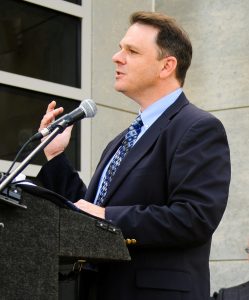
TUSCALOOSA, Ala. — After more than 26 years in the museum profession, Dr. William Bomar was ready for a new challenge — and he found it as the executive director of The University of Alabama Museums.
Bomar, director of UA’s Moundville Archaeological Park since 1998, was selected for the position after serving as the interim director since May 2013. As executive director, he will be responsible for overseeing the activities of UA’s museum system, which includes the Alabama Museum of Natural History, Moundville Archaeological Park, Gorgas House, Museum Research and Collections, Office of Archaeological Research and the Emmy award-winning television program “Discovering Alabama.”
“Dr. Bomar has experience with many types of museums, both at UA and in his previous positions, and is well qualified to lead the UA Museums,” said Dr. Joe Benson, UA interim provost, who named Bomar to the position following a national search.
Bomar already has big plans for the future of UA’s Museums.
“The Association of College and University Museums and Galleries often says ‘great universities have great museums,'” he said. “As the institution with arguably the oldest university museum in the U.S., dating to its founding in 1831 when a curator was employed to collect specimens and produce exhibits in the Rotunda building, The University of Alabama should be a national leader in teaching, research and public service through its museum system.
“Broadly speaking, I want UA Museums to gain national notoriety among university museums and triple our educational impact in 10 years.”
Citing the museums’ diverse collections that are commonly used for research by faculty, students and scholars from both UA and other institutions, Bomar said he wants the museums to expand that role as facilitators of research and also play a stronger role in the dissemination of knowledge to the community through state-of-the-art exhibits and a vast array of educational programs.
“That’s what museums do best,” he said. “We take complex information and present it to the public in fun and engaging ways. We are community centers for lifelong learning and critical thinking.”
Prior to coming to Moundville in 1998, Bomar worked at the Atlanta History Center, Nebraska State Historical Society, Coastal Heritage Society in Savannah, Georgia, and the Georgia Southern University Museum. Because of his experience in each type of museum represented by UA Museums, Bomar said he understands the unique challenges associated with historic houses, natural history museums and outdoor heritage sites.
“I am extremely excited about this opportunity,” he said. “Yes, I will miss working every day at such a beautiful and special place, but I have been at Moundville for a long time and accomplished a lot. I am ready for new and exciting challenges. Moundville is one of the most significant archaeological sites in the U.S., and the site has an incredible story.
“But the other UA Museums also have incredible stories to tell. Alabama is one of the most environmentally diverse states in the U.S., and its incredible fossil record illustrates this story over vast periods of time. I believe that the museum setting is truly the best medium for telling such a story, and, through our collections, curators and staff, we are best equipped to tell it.”
Contact
Kim Eaton, UA Media relations, 808/640-5912, kkeaton@ur.ua.edu
Source
Dr. William Bomar, 205/348-7551, bbomar@ua.edu